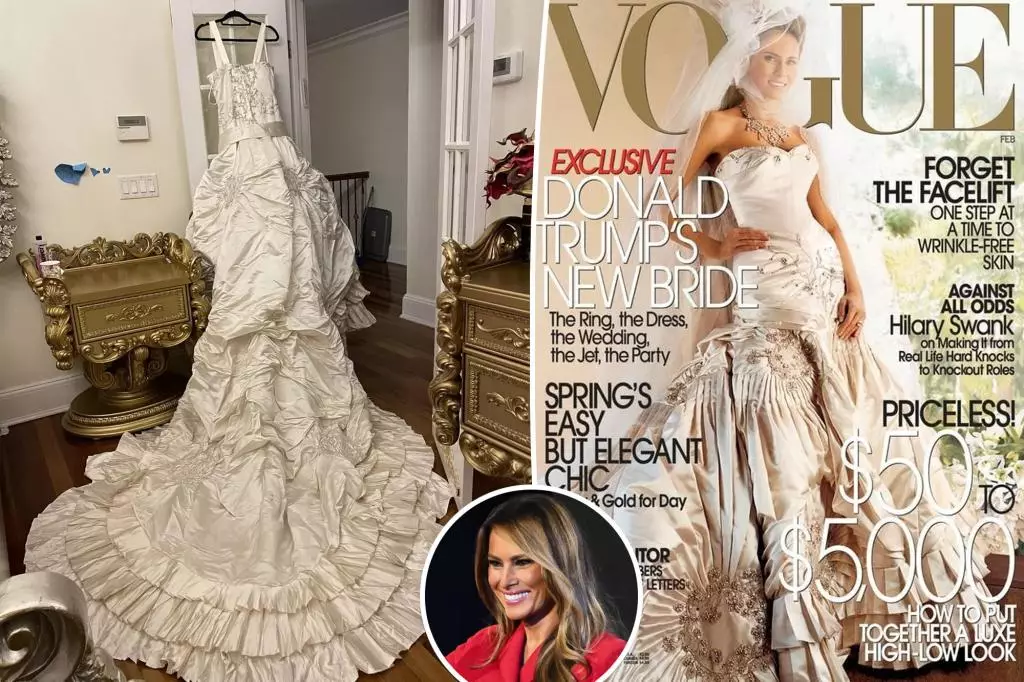Melania Trump’s wedding dress, a stunning creation by Christian Dior under the direction of designer John Galliano, is now finding its way into the marketplace, sparking conversations around not just the dress itself but the prestige and memories it carries. Initially purchased for an eye-watering $100,000, this gown, which symbolizes a pivotal moment in American pop culture and politics, is being offered on eBay for $45,000, opening up a window for collectors and fans to own a piece of history. The presence of the dress on eBay, coupled with its intricate craftsmanship, is generating buzz that transcends mere consumerism—it raises questions about the value we place on celebrity and significance.
The Journey of an Iconic Dress
The dress is more than just fabric and embellishments; it’s a narrative of love, celebrity, and the complexities of public life. It was famously showcased on the cover of Vogue shortly after Melania and Donald Trump exchanged vows in January 2005, an event attended by a wealth of notable personalities, from political figures to cultural icons. Featuring 300 feet of white duchesse satin and crystals hand-embroidered over 550 hours, the gown is designed not only to catch the eye but also to embody the extravagant lifestyle that Melania embraces. The logistics of wearing such a heavy gown—reportedly weighing 60 pounds—speak to the theatricality required of a high-profile wedding, not just for the couple but for those watching from the outside.
The story of the dress itself, including its somewhat dubious journey to eBay, only amplifies its mystique. A seller claims to have bought the dress from Melania for her own wedding at a price of $70,000; this suggests not just the dress’s enduring allure but also ignites discussions about authenticity and resale in the high-fashion world. Minor alterations made by the current owner raise additional questions about the preservation of a couture piece that is inseparable from its original context.
Fashion as a Reflection of Identity
Fashion, especially in the context of high-profile weddings, often reflects the identity of those who wear it. Melania’s choice of a Dior gown, assisted by fashion luminary Anna Wintour, indicates a conscious alignment with luxury and style. The resulting blend of fashion with political stature turned Melania’s wedding into a national spectacle. President Trump’s retrospective acknowledgment of their two decades of marriage through a nostalgic Instagram post featuring the iconic gown speaks volumes about how intertwined personal and public narratives can be.
Moreover, the gown functions as a symbolic artifact in a shifting cultural landscape—one that includes a former first lady navigating her identity in the aftermath of her husband’s controversial presidency. In an era where fashion can be both a personal statement and a political tool, understanding Melania’s dress becomes a lens through which we explore the intersection of celebrity culture and political identity.
What Will the Dress Say Next?
As the gown continues its journey in the marketplace, it poses an interesting dilemma: what do we, as consumers and society, value in these iconic pieces? The transformation of Melania’s wedding dress from an emblem of a unique love story to an object available for purchase highlights contemporary cultural shifts. It serves as a reminder that clothing can transcend its function—carrying legacies, evoking emotions, and sparking conversations about celebrity and status. In its new life, the dress will surely continue to tell stories, raising an intriguing question: what narratives will it inspire for its next owner?

